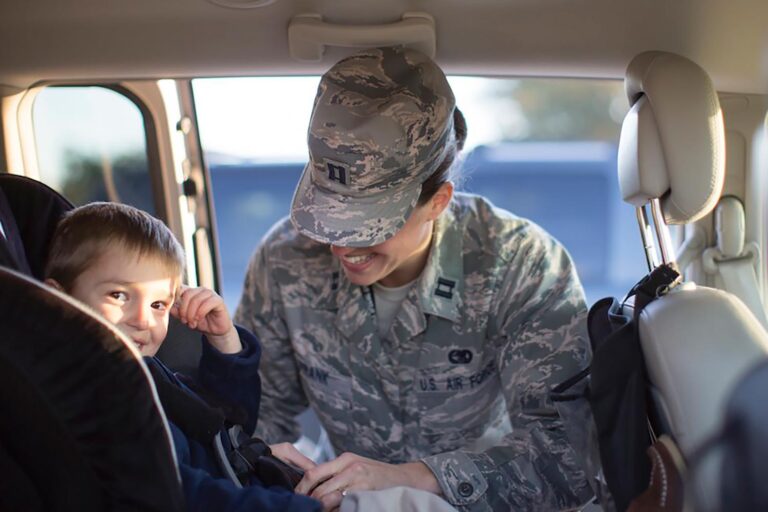
Essential Military Financial Advice to Secure Your Future
Many people have questions about financial security when it comes time to plan out your financial future. Most people receive advice to open a savings and checking account and contribute to a retirement fund, but what other valuable financial tips should they follow? Many who are in the military also have specific financial needs, and military financial advice sometimes differs from conventional wisdom. Read on to learn more about the importance of good military financial advice and military budgeting. Introduction to Military Financial Advice Financial planning is important to everyone, especially military personnel. The type of military financial advice and military budgeting commonly given to Servicemembers might be different from good advice for civilians. Effective financial strategies can enhance long-term financial stability, particularly for individuals deployed for extended periods. For example, while it is true that the Veterans Administration has several programs for military families in need of financial assistance with moving or loans, it is always a good idea to have an emergency fund on hand for quick cash if needed in emergencies. For the Servicemember who might be on deployment overseas and is not married, some good military financial advice is to declare a trusted

Veteran Jobs: Top Career Opportunities for Military Veterans
Military personnel and Veterans returning from service have many options available to them for employment in the civilian workforce. Many see military service as a good way to receive post-secondary vocational training and education when they otherwise would not have been able to afford it. Many jobs in the military transfer well to civilian service, including opportunities for disabled Veterans. Read on to learn more about programs and resources, as well as federal jobs for Veterans seeking employment after their military service. Career and Employment Resources for Veterans There are many programs available specifically aimed at assisting Veterans to find employment once they leave the military. Many of these include government initiatives, support programs, online programs, and other resources through the Department of Veterans Affairs (VA). In addition to these programs, the GI Bill, which you can read more about at this link, also offers educational opportunities in conjunction with these Veteran jobs programs. Here are some of the programs offered to those looking for Veteran jobs: VA for Vets: There are many VA careers for Vets within the Veterans Administration itself, and preferential treatment for some jobs is often given to former Servicemembers who apply. Employment

Lululemon Military Discount: Get 15% Off Your Purchase
Many organizations and businesses make efforts to show their appreciation for those who served in the military by offering several benefits and special offers to Veteran customers. Many retailers offer discounts on products, free services, and special considerations when doing business with Servicemembers and Veterans. Lululemon active wear is popular among those who look to stay in shape, especially those in the military with physically strenuous jobs and might be interested in affordable exercise attire. Read on to learn more about the Lululemon Military Discount. Understanding the Military Discount at Lululemon While shopping for Lululemon products, first responders, Veterans and qualifying Servicemembers may get as much as a 15% Lululemon Veteran discount on the brand’s products. In many cases, the spouses of these individuals are also eligible for the Lululemon military discount. You can use it both online and in Lululemon stores. You cannot combine it with other offers, promotional codes, discounts, and coupons. The discount cannot be used in combination with gift cards, Klarna, Afterpay, or PayPal for online transactions. This discount can help military families save money on activewear, which can be particularly beneficial considering the needs and demands of military life. Discounts are also

VA Loan HELOC: Unlock Your Home Equity with a VA Home Equity Line of Credit
Many people find themselves facing unexpected financial hardships or issues, for which they need immediate access to cash. Often, some choose to take out a loan dedicated to the purpose, but for others, especially those who might not qualify for a new loan on top of existing ones, borrowing against a home’s equity is a viable option. A home equity line of credit (HELOC) is a revolving loan, like a credit card, that allows you to borrow against the equity you’ve built in your home, offering flexible access to funds and repayment options. For Veterans and Servicemembers who have VA-backed home loans, a VA-backed HELOC with favorable terms and rates is an attractive financial decision. It is not, however, without its risks, and in some cases, a VA loan HELOC comes with certain stipulations and restrictions. What is a VA Loan HELOC? A HELOC is a line of credit secured by the equity in your home, meaning you can borrow up to a set limit and repay as needed, similar to how a credit card works. If you fail to repay the loan, your home could potentially face foreclosure. In typical HELOCs, you will have a credit

VA Cash Out Refinance: Unlock Your Home’s Equity with a VA Loan
There are many ways to utilize the equity in your home to access money needed for large expenses. There might be many reasons for doing this, usually large medical bills, the need to finance home repairs, or to pay off debt. Your home is the biggest asset you likely have, and using its value to pay off these expenses has many benefits but is also not without risk. A cash out refinance loan is one such way to convert your home equity into usable money. The Veterans Administration (VA) offers several home loan opportunities, and this option is one of them. The VA cash out refinancing process is also fairly straightforward. Read on to learn more. What is a VA Cash Out Refinance? Not many people are familiar with cash out refinance loans, as home equity lines of credit or refinancing are more popular ways of making use of home value. However, for a cash out refinance, this is a process in which you replace your existing mortgage with a newer, larger loan and use the proceeds to pay off your existing mortgage. You receive the remaining amount as a lump sum payment and proceed to make

VA Education Benefits for Dependents and Survivors: A Comprehensive Guide to Available Programs
The decision to join the military comes with a variety of benefits for Servicemembers, Veterans, and retirees. However, some Servicemembers with families also consider military service for the VA survivor benefits their spouses and dependents can take advantage of. The Veterans Administration provides access to a variety of benefits for the dependents and survivors of Veterans and military personnel. What Are VA Education Benefits for Dependents and Survivors? Most people looking to join the military for educational benefits are aware of the various sections of the GI Bill, which provides education assistance, tuition reimbursement, and many other benefits to those who qualify, which is covered more in-depth at this link. However, the families of Servicemembers also have access to certain educational benefits through the VA through GI Bill transferability. VA education benefits for dependents depend on the qualifications and type of service of the sponsoring Servicemember. Veteran dependent education benefits might differ also based on whether or not the Servicemember has also utilized these benefits for himself before passing them on to a family member. The qualifications for dependents benefits are: You are the spouse or child of a Servicemember who has died, has a permanent

Debt Help for Veterans: Solutions to Ease Financial Struggles
The rising cost of commodities and necessities due to inflation and uncertain economic times caused many Americans to experience financial uncertainty and growing debt. Unexpected healthcare costs, expenses, or repairs often lead many people to put these expenses on credit cards or take out loans to afford them. As a result, many individuals find themselves burdened with mounting debt that they struggle to repay. The Veterans Administration (VA) offers debt relief programs for Veterans to help Servicemembers and Veterans avoid these problems, particularly with assistance programs towards healthcare, education, home loans, and other benefits. For this reason, the VA provides a multitude of services and debt relief for Veteran programs designed to help military personnel eliminate or reduce their debt. This article examines some of these debt relief programs for Veterans, including who is eligible and how to apply for them. General Debt Relief for Veterans Many financial institutions offer debt relief for Veterans by placing a freeze on loan repayments while someone is serving in the military, but many others do not. It is important to have the correct resources and information before starting a debt relief program of any kind, especially debt relief programs

The Ultimate Guide to Veteran Auto Insurance: Best Providers, Discounts, and Coverage Options
In an effort to show appreciation to those who serve the nation, especially in defense, many private industries offer special deals, discounts, and bonuses to Veterans. Veterans in particular qualify for a variety of specific Veteran auto insurance deals, especially the popular USAA insurance for Veterans. Veterans should know that they may be eligible for many different military discounts, and they should compare policies from different companies to find the best coverage and rates, including those offered by companies like USAA, GEICO, and State Farm. Several providers even offer specific disabled Veteran car insurance for those with a service-connected disability. Car insurance for Veterans usually comes with standard benefits, such as roadside assistance, uninsured motorist coverage, and personal injury protection, while also giving special bonuses for conditions unique to the military, such as the need to relocate frequently or discounted rates for those living on disability income. Read on to learn which of the best auto insurance for Veterans policies work for you. What is Veteran Auto Insurance and Who is Eligible? “Veteran’s auto insurance” refers to car insurance policies and discounts specifically tailored for Veterans and their families, often offered by companies like USAA, GEICO, and

Best Military Auto Insurance: Top Providers, Discounts, and Coverage for Service Members
Members of the US Armed Forces, Veterans and retirees, as well as their families, often enjoy several benefits that come with being Servicemembers. There are both federal and state-level discounts and even free services available to qualifying Servicemembers. With regards to insurance, there are several military insurance deals available. Military car insurance often offers better coverage, discounted rates, and special protections during times of deployment than civilian insurance. Servicemembers find that some car insurance military discount offers, such as the Geico military discount, help to offset other expenses that come with enlistment in the military, such as frequent moving costs and the need to store a vehicle before deployment. For Servicemembers and Veterans, understanding auto insurance also means looking for discounts, considering unique needs like deployments and storage, and being aware of protections like the Servicemembers Civil Relief Act (SCRA). Keep reading to learn more about the best auto insurance for military members currently available. What is Military Auto Insurance and Who is Eligible? Military auto insurance is a type of car insurance specifically designed for active-duty military personnel, Veterans, and their families, often offering special discounts and benefits not available to the general public. Specific eligibility

2025 VA Disability Rates: Monthly Payment Rates for Veterans
Below you find the 2025 Veterans disability compensation rates. You can use these compensation benefits rate tables to find your monthly payment amount which is based on your disability rating and details about your dependent family members. Compensation rates for Veterans with a 10% to 20% disability rating Note: If you have a 10% to 20% disability rating, you won’t receive a higher rate even if you have a dependent spouse, child, or parent. Disability rating Monthly payment 10% $175.51 20% $346.95 Compensation rates for Veterans with a 30% to 100% disability rating With a dependent spouse or parent, but no children Compensation rates for 30% to 60% disability rating Find the dependent status in the left column that best describes you. Then look for your disability rating in the top row. Your basic monthly rate is where your dependent status and disability rating meet. If you have more than one child or your spouse receives Aid and Attendance benefits, be sure to also look at the Added amounts table, and add these to your amount from the Basic monthly rates table. Basic monthly rates Dependent status 30% disability rating 40% disability rating 50% disability rating 60% disability rating Veteran alone (no dependents) $537.42 $774.16 $1,102.04 $1,395.93
